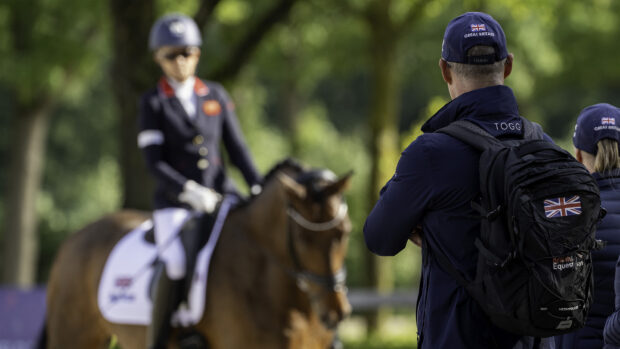Flying changes are a challenge to master at the best of times, but what about when you don’t have legs? Grade III para rider and European gold medallist Erin Orford, who had both legs amputated aged one, fills us in on how she trains her horses, with and without wearing prosthetic legs
“I have been riding without my prosthetic legs for a couple of months now; Dorset Orthopedic are making me new riding legs, but it’s a very long process and Covid has brought additional challenges, so I thought I’d try riding without legs for now,” says Erin Orford, who won European team gold and individual bronze in 2017 and team silver at the World Equestrian Games in 2018, both with Dior.
“The biggest difference to me when riding without legs is the weight as the legs are quite heavy so they can throw me around in the saddle and I’ve had to work hard on my core to compensate for this. But the adjustment is probably not huge for the horse because I have very limited use of my legs when I do ride with them – the majority of my aids come from my seat and weight, and my thigh.
Loki gave me an early Christmas present, a clean flying change each way with no legs ? what a special pony ? ? Sophie Wells Mbe Dressage HC Dressage Lady Joseph Trust
Posted by Erin Orford Para-Dressage on Tuesday, December 22, 2020
“I recently competed my up-and-coming horse LJT Diamond Crusador, aka Loki, in able-bodied dressage for the first time. We did two elementary qualifiers before Christmas and I put my legs on for the show and he can adapt easily as the aids are very similar,” added Erin, who scored over 77% to qualify for the regionals at elementary. Erin, who trains with fellow para medallist Sophie Wells, would love to compete at prix st george level in able-bodied dressage alongside para classes, having already competed up to advanced medium previously.
Article continues below…
You might also be interested in:

The rise of para dressage *H&H Plus*
The sport has come a long way since the first equestrian Paralympics 24 years ago. Polly Bryan looks at the

9 things you have to know about double world gold medallist Sophie Wells
Find out more about the rider who scooped two brilliant gold medals for Britain at the World Equestrian Games in

Para rider back in the saddle after serious fall derailed her squad dreams
‘Because of the rods in my back I was worried when I fell as all it would take is for
“It’s really interesting riding without legs as it shows how much can be done from the seat and weight distribution, for example lifting my pelvis to allow him to come through on the new lead when doing changes. Loki can feel a bit of pressure from my thigh as a horse would do ordinarily; I don’t have the obvious aid of putting my leg back, but he can feel my thigh, and we have been teaching him the higher level movements using some voice aids as well, just to give him a bit more support as he is only just eight.
“Even though I have less, what I do have I have complete control over, so I can make my aids very specific and it gives me a different feel to be able to influence the horse in a better way. As long as he is responsive and in front of the leg to go forwards for himself – which they all should — I can influence the rest.”
Would you like to read Horse & Hound’s independent journalism without any adverts? Join Horse & Hound Plus today and you can read all articles on HorseandHound.co.uk completely ad-free




